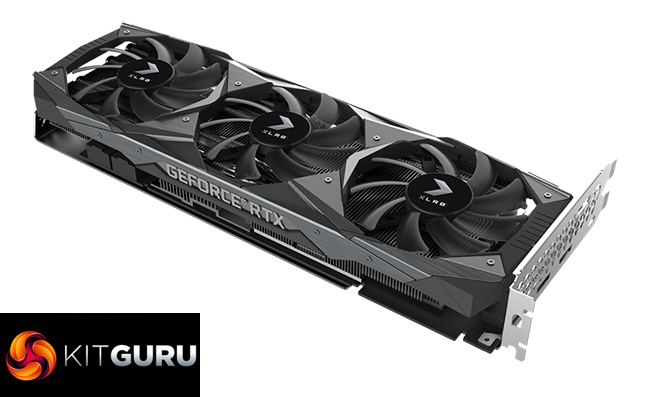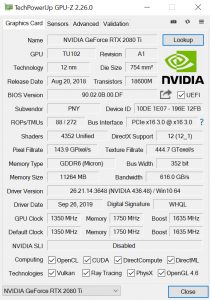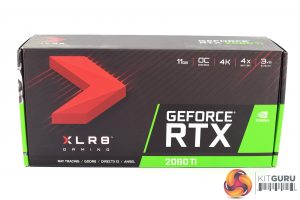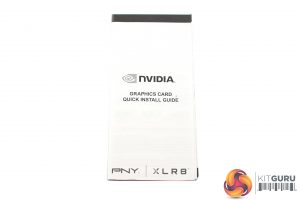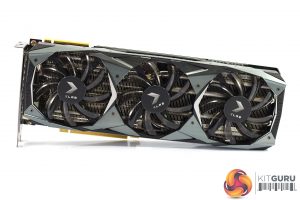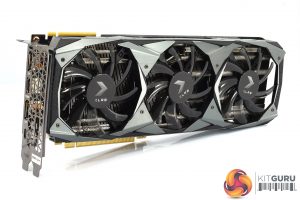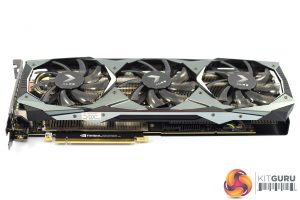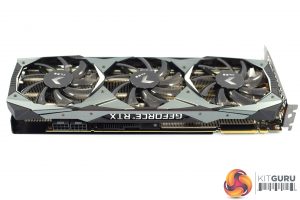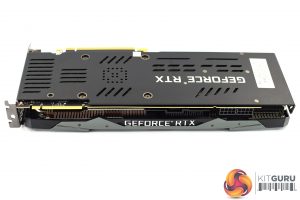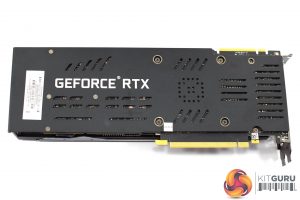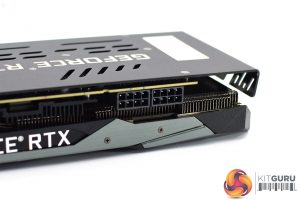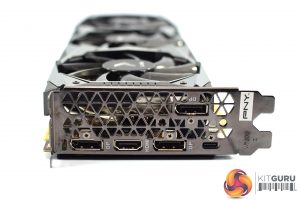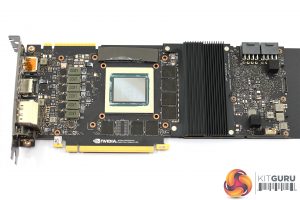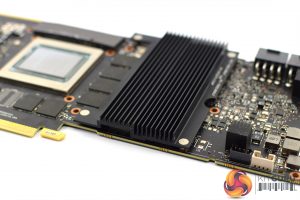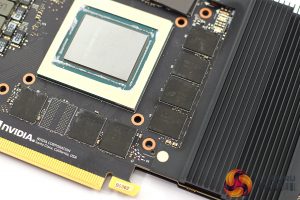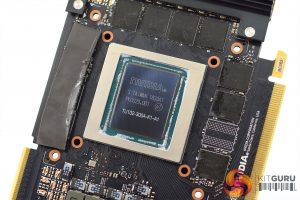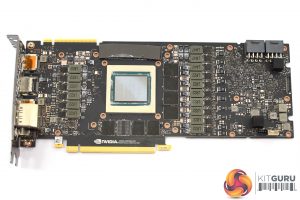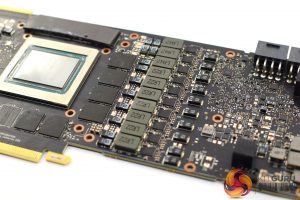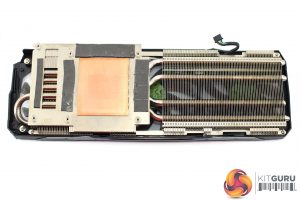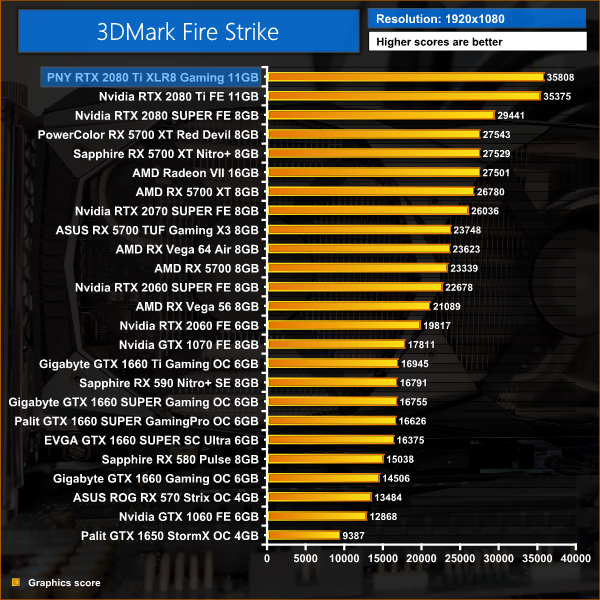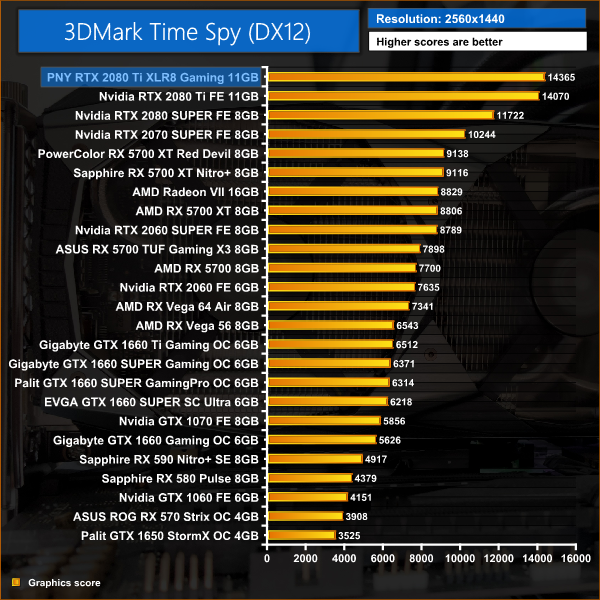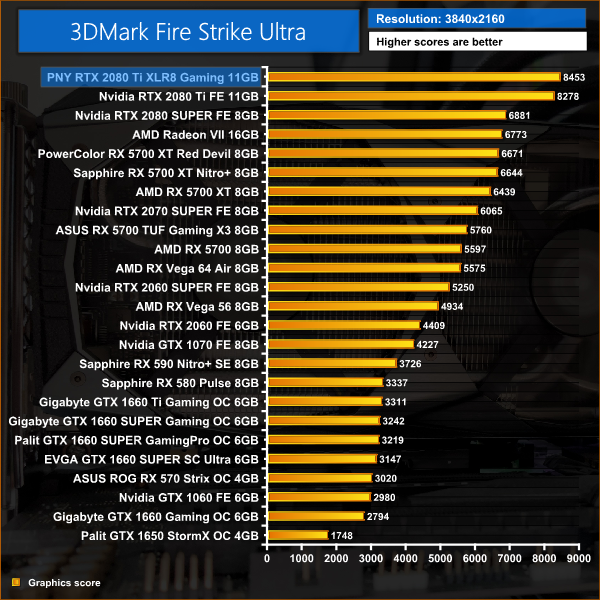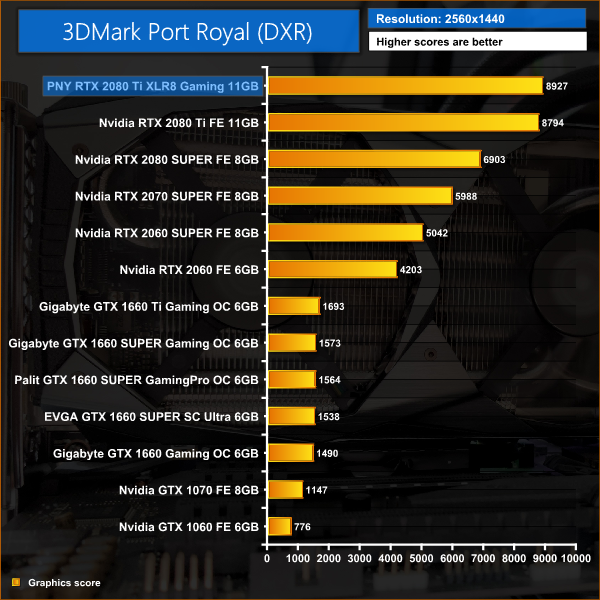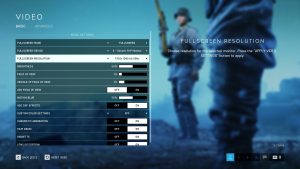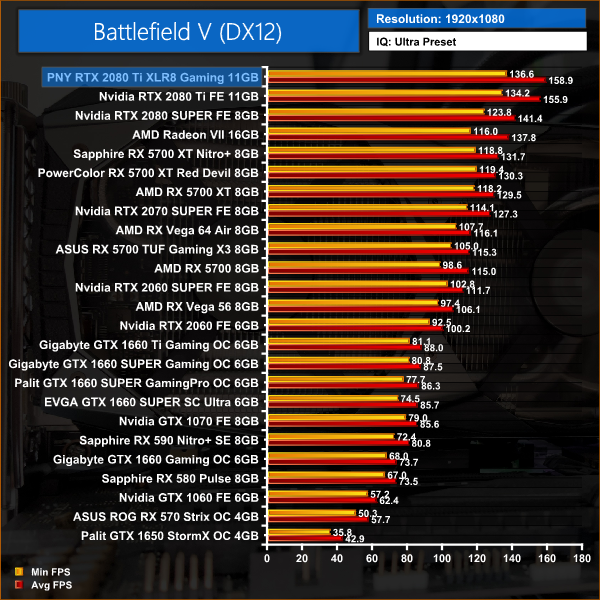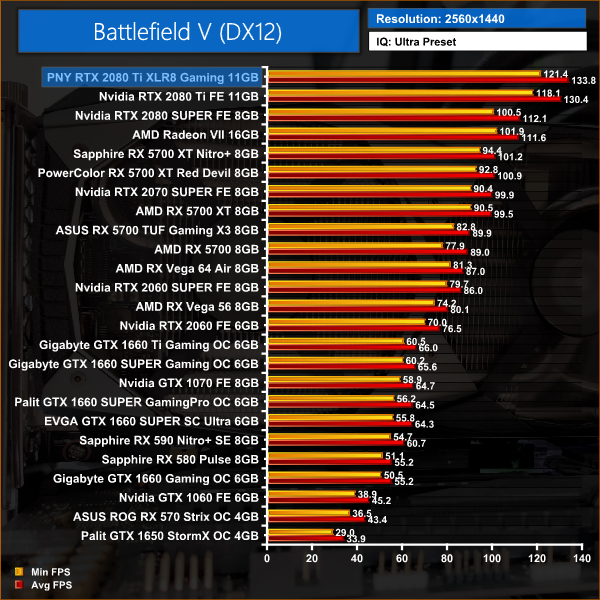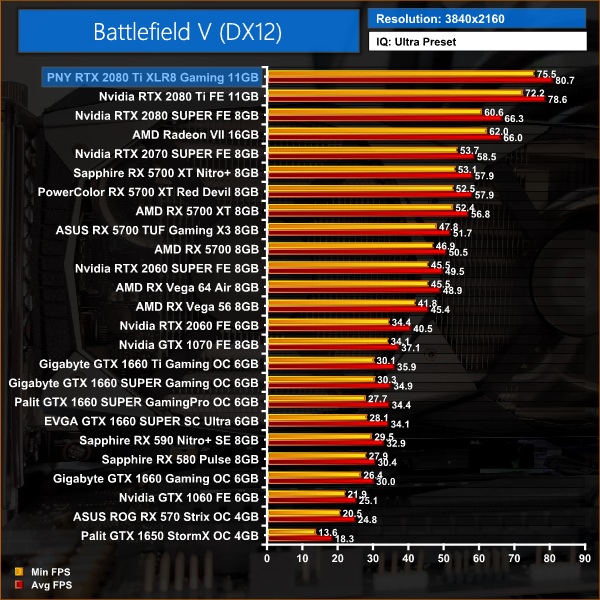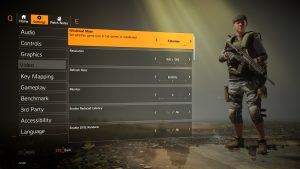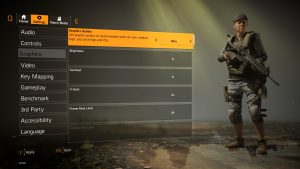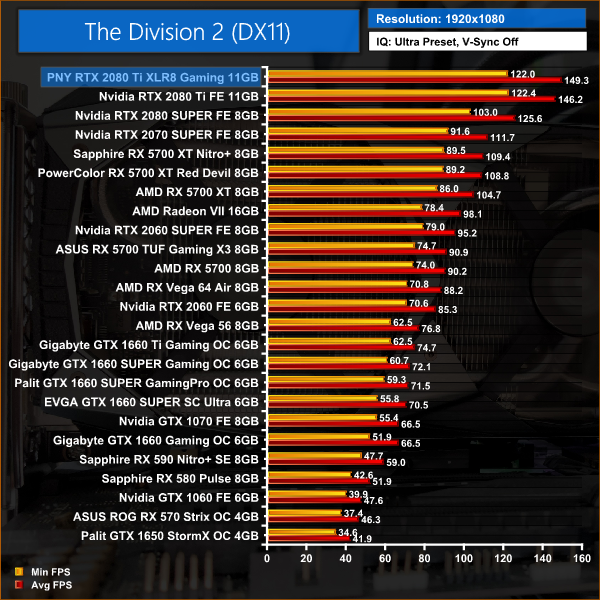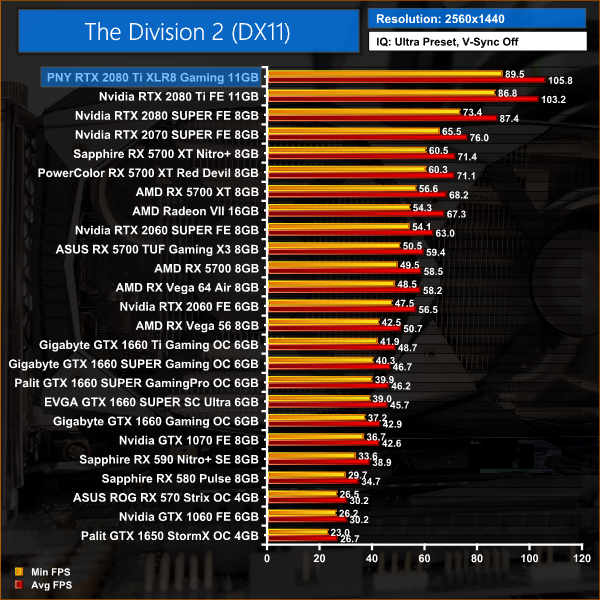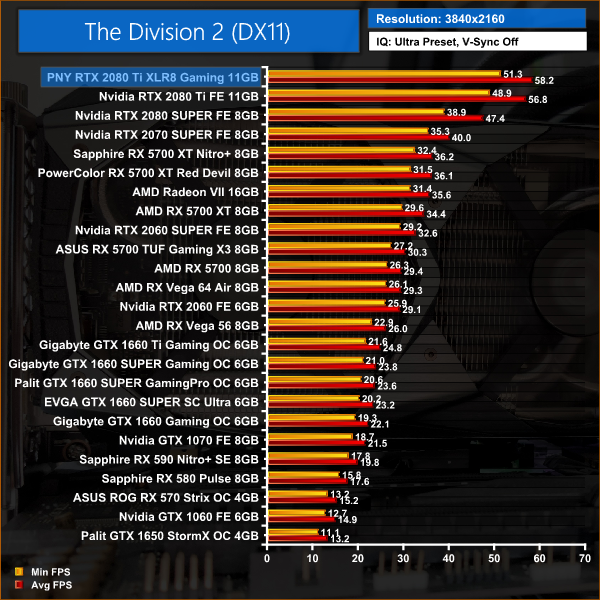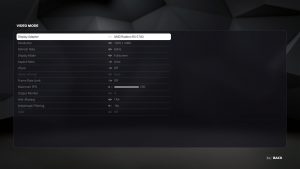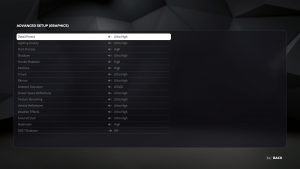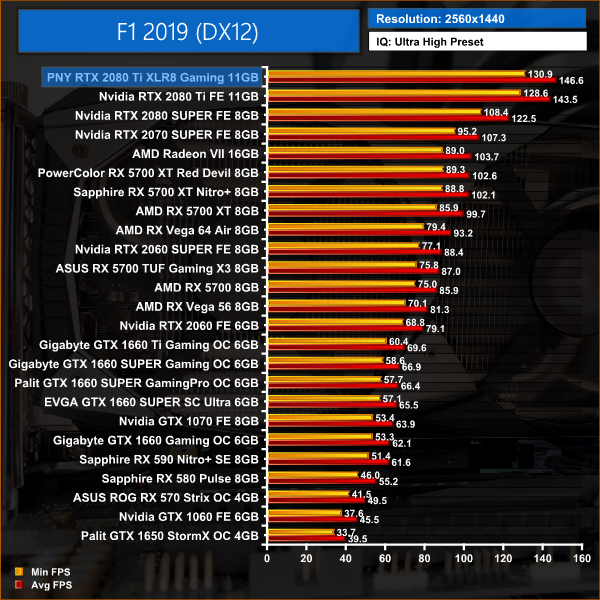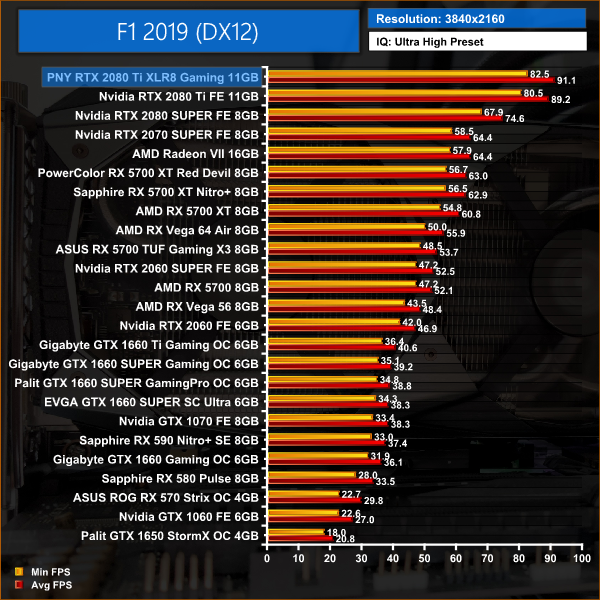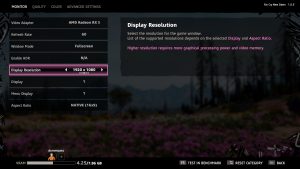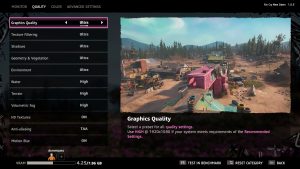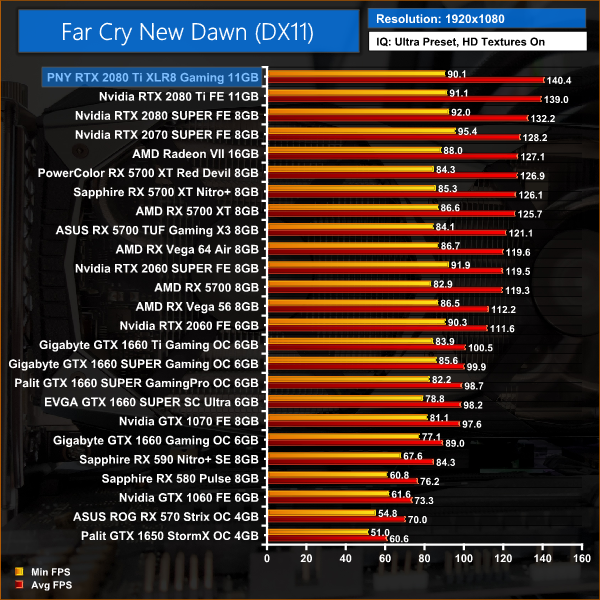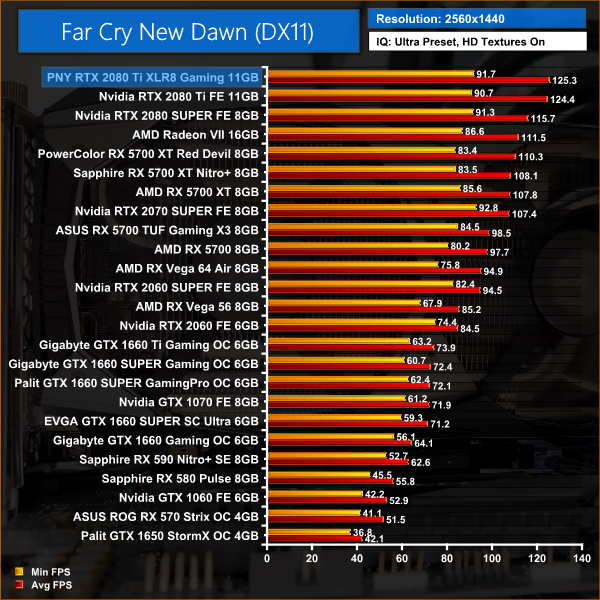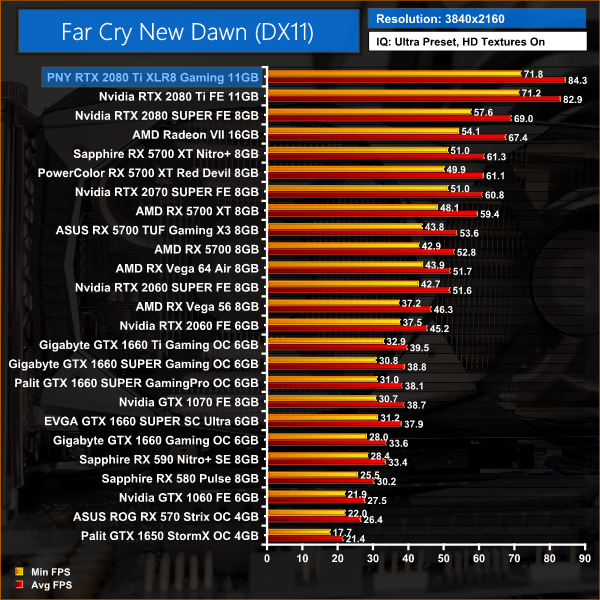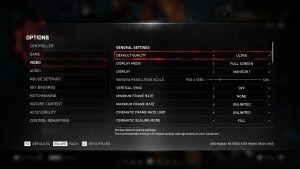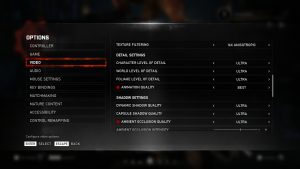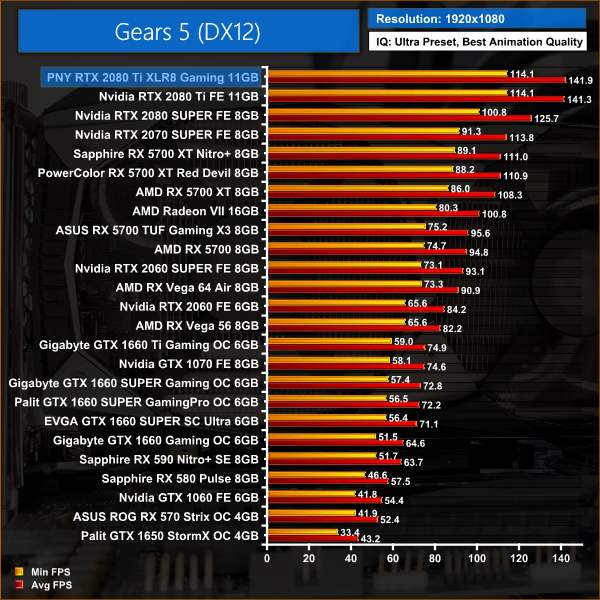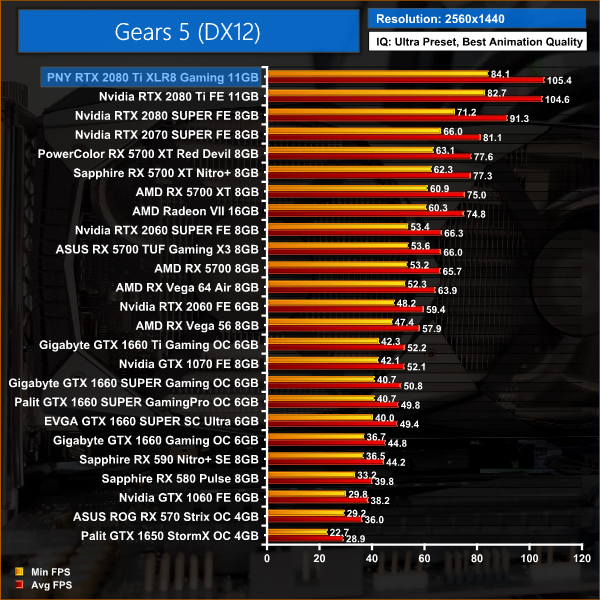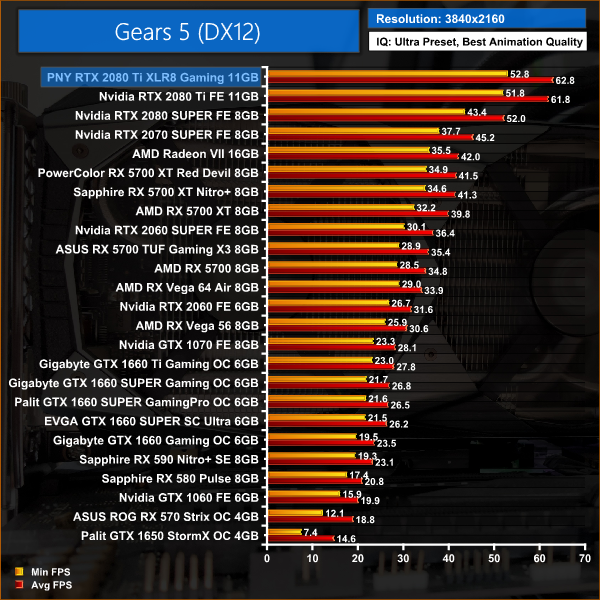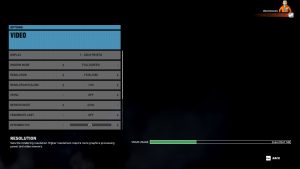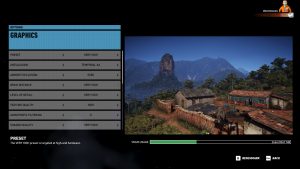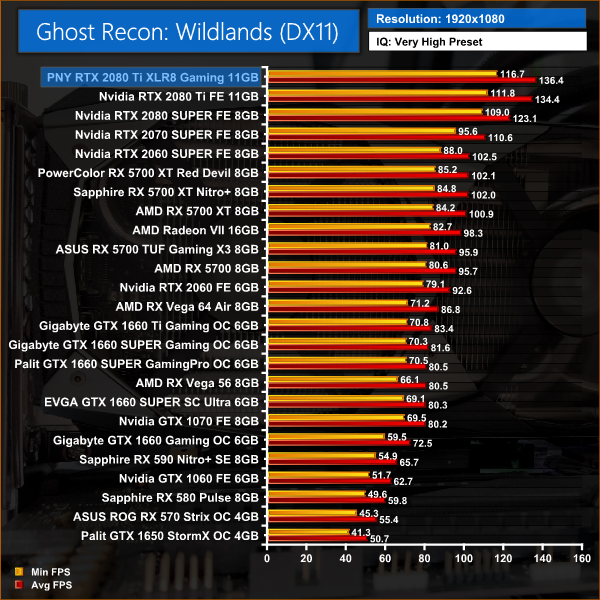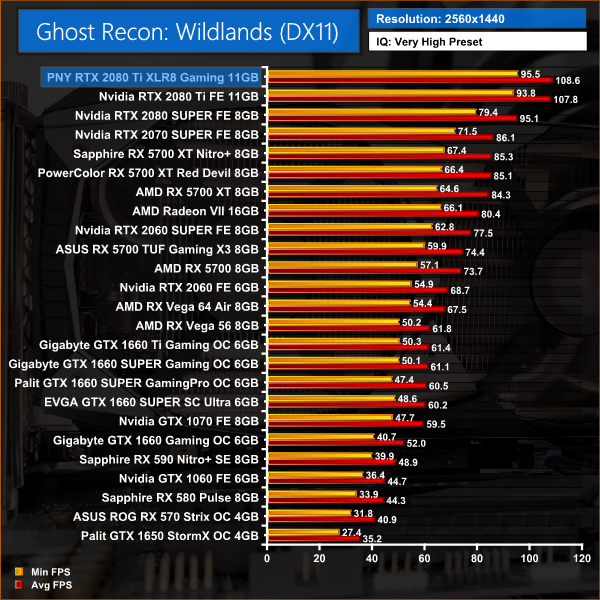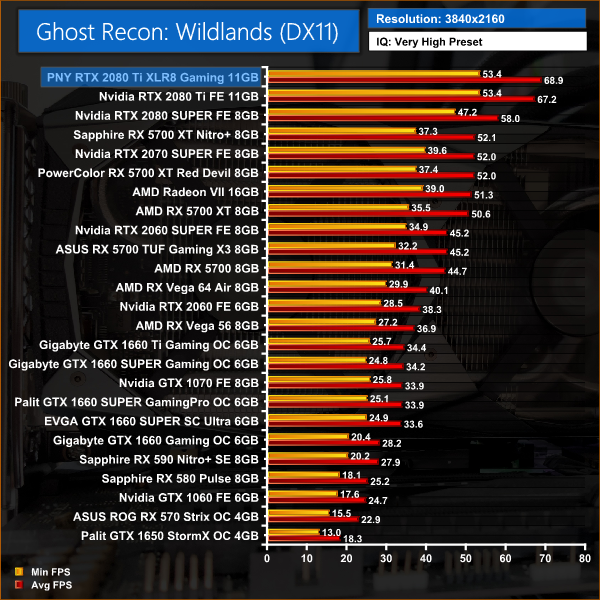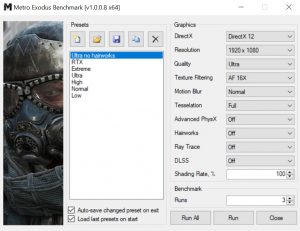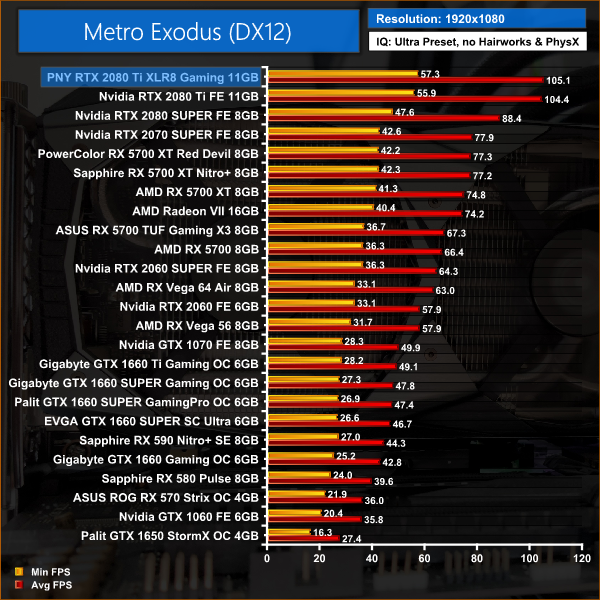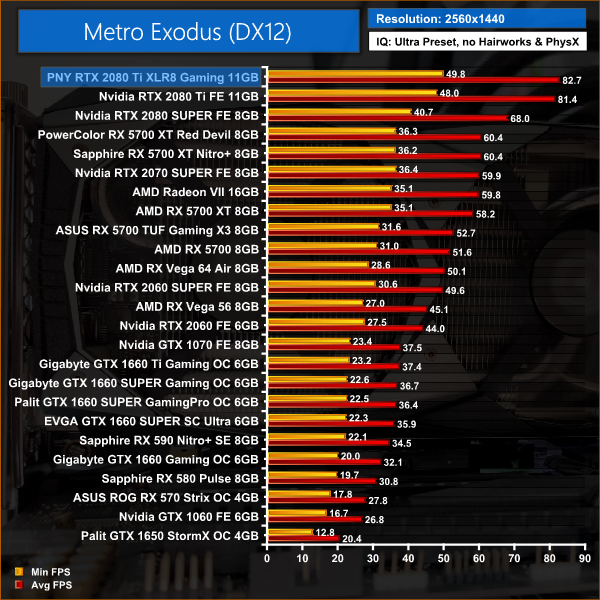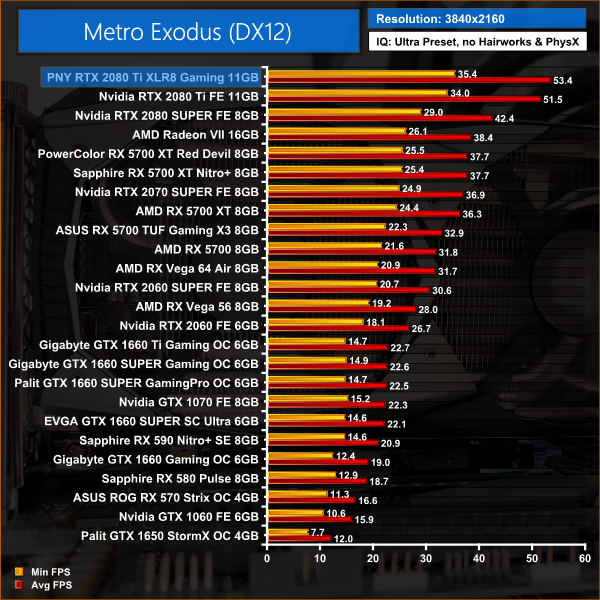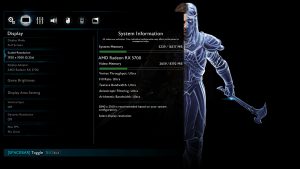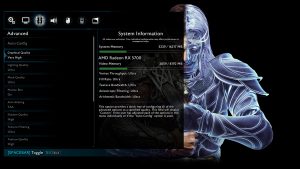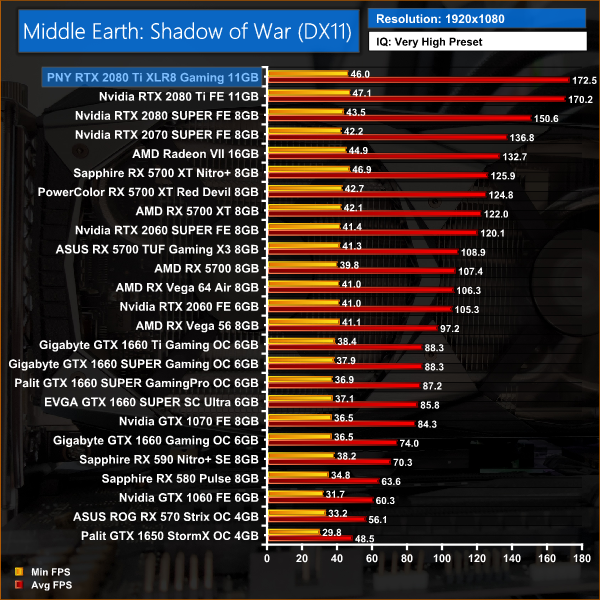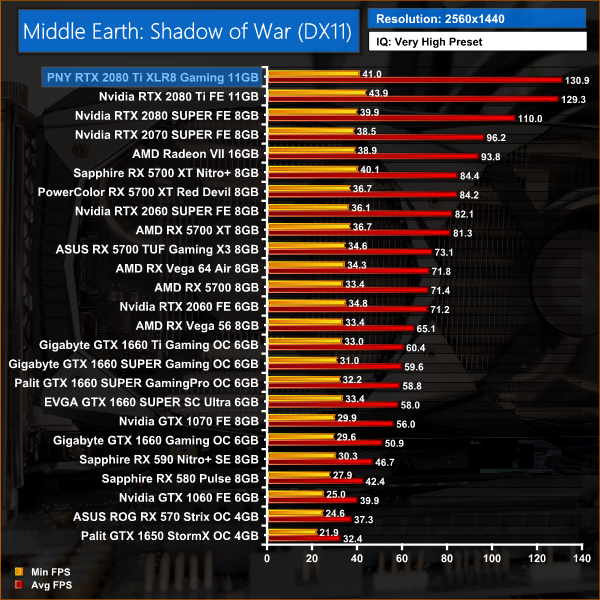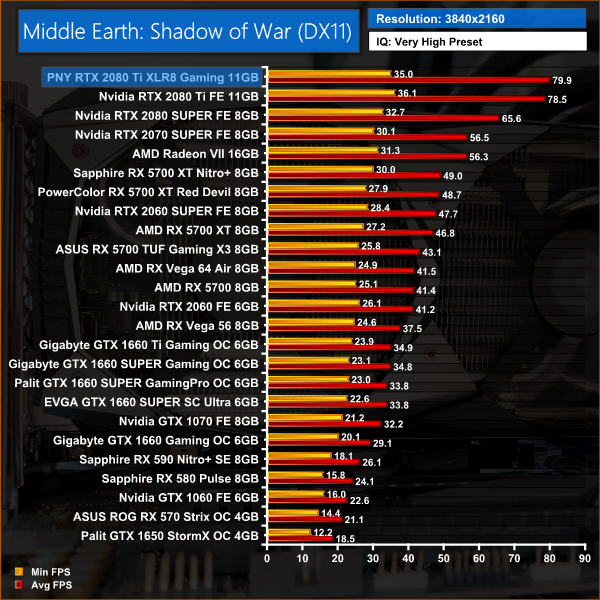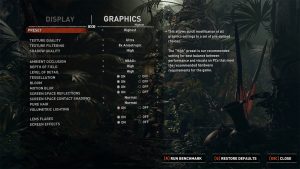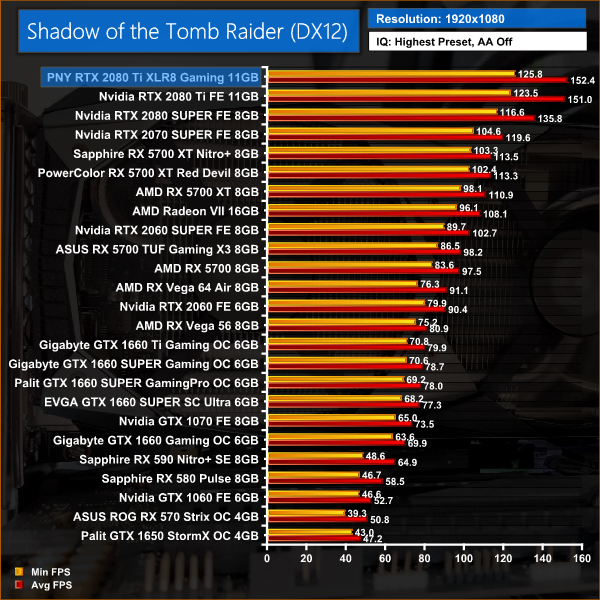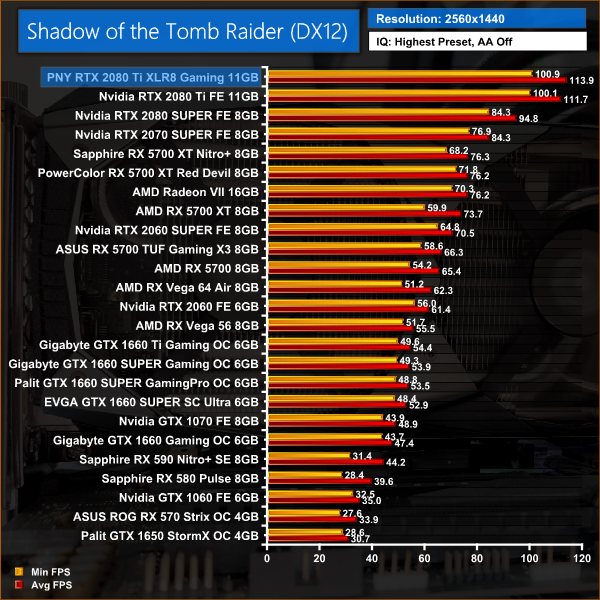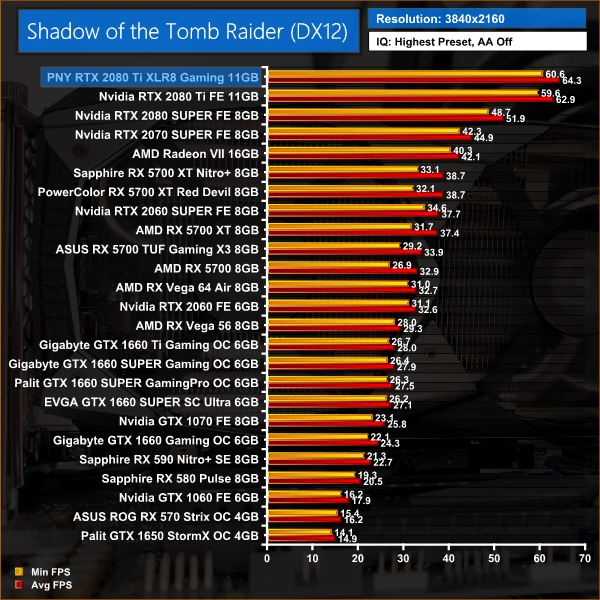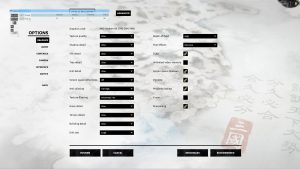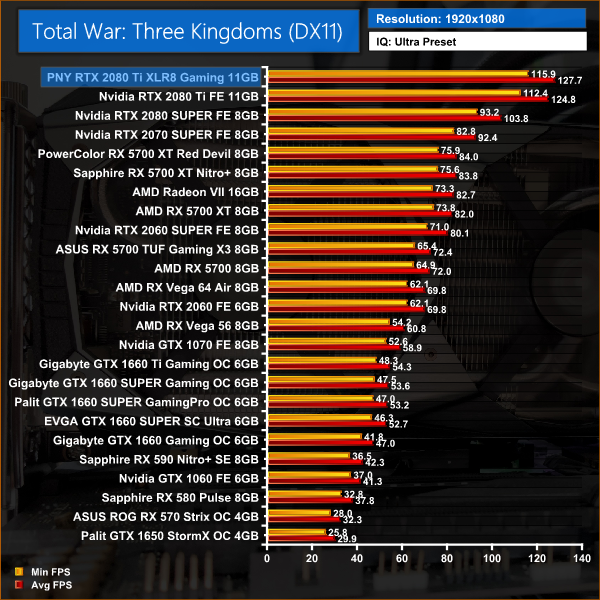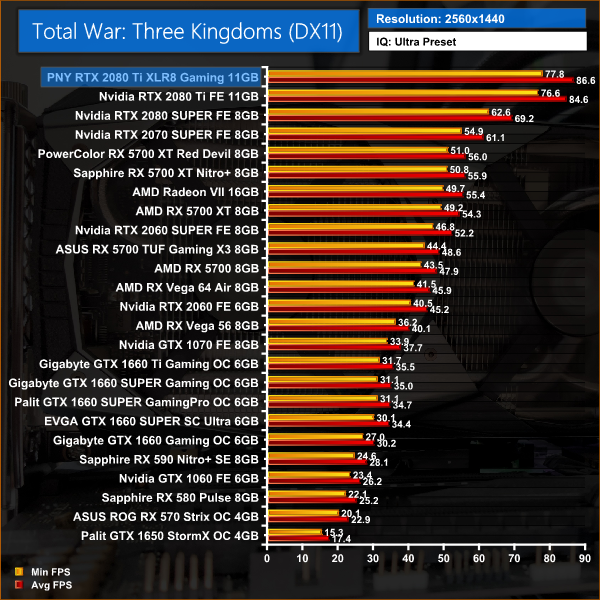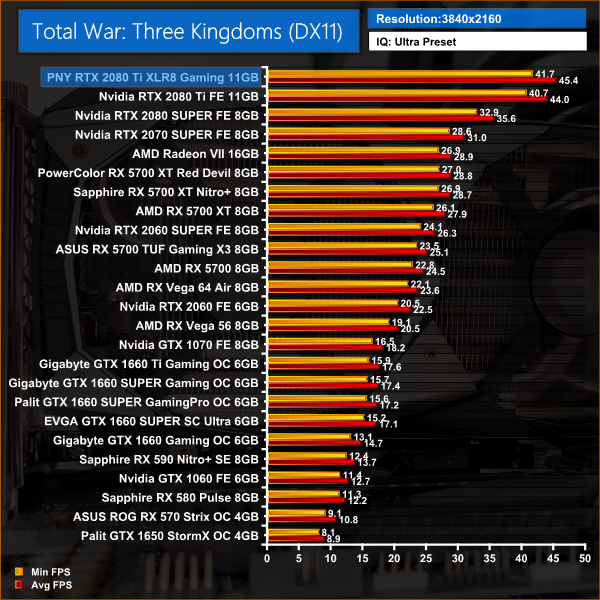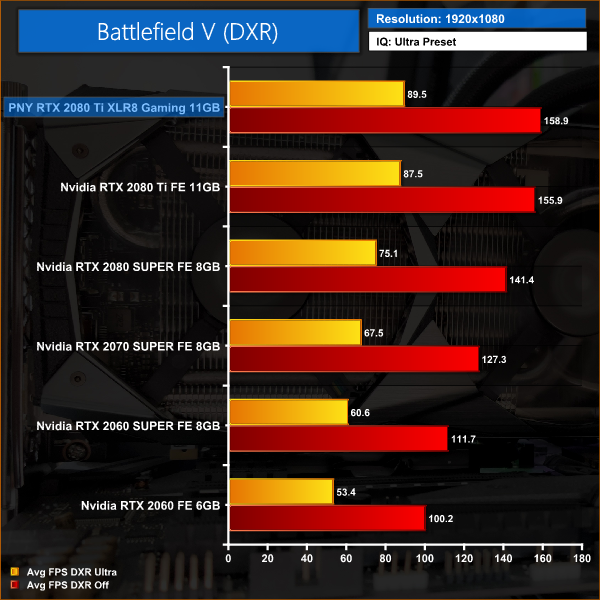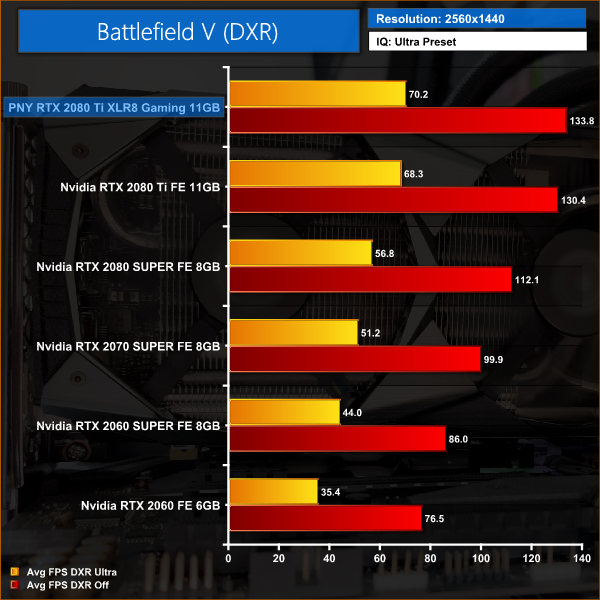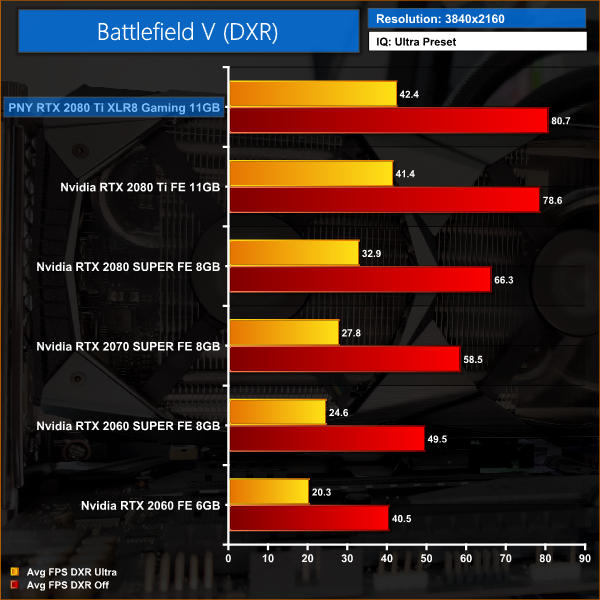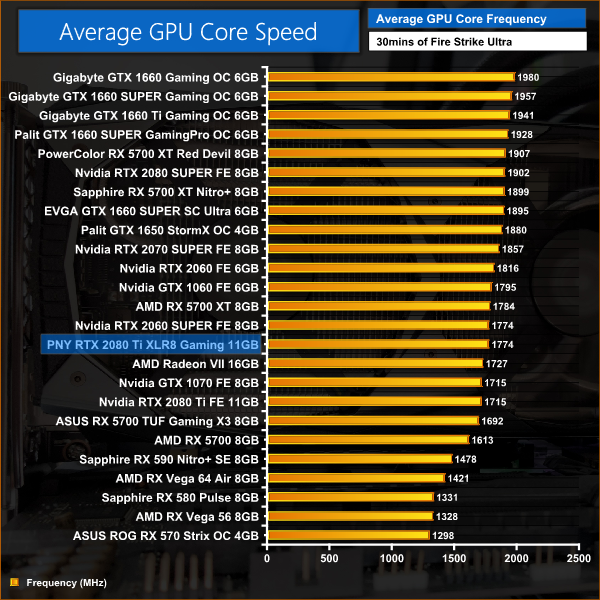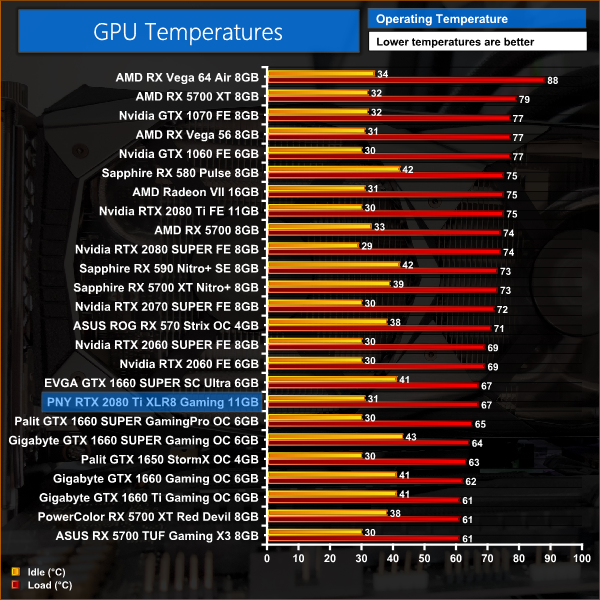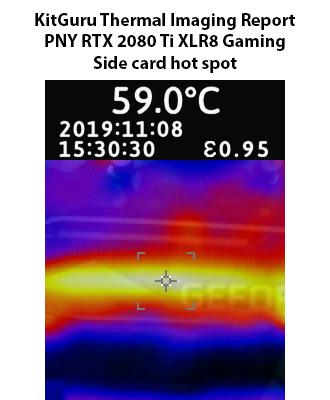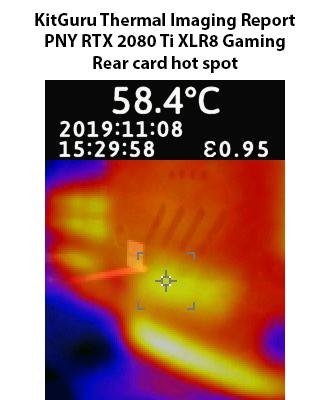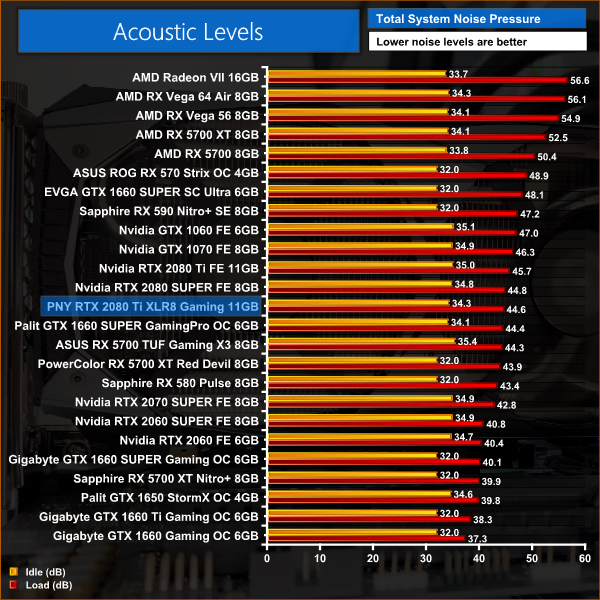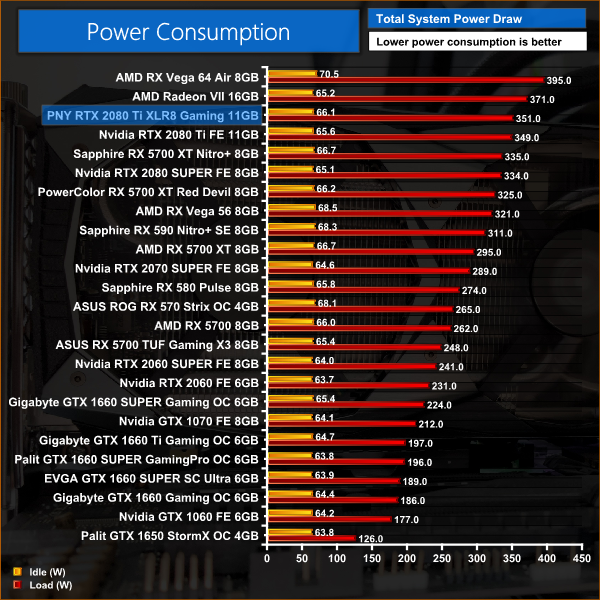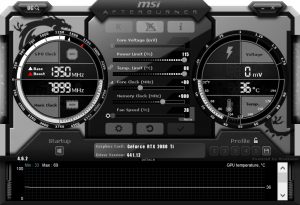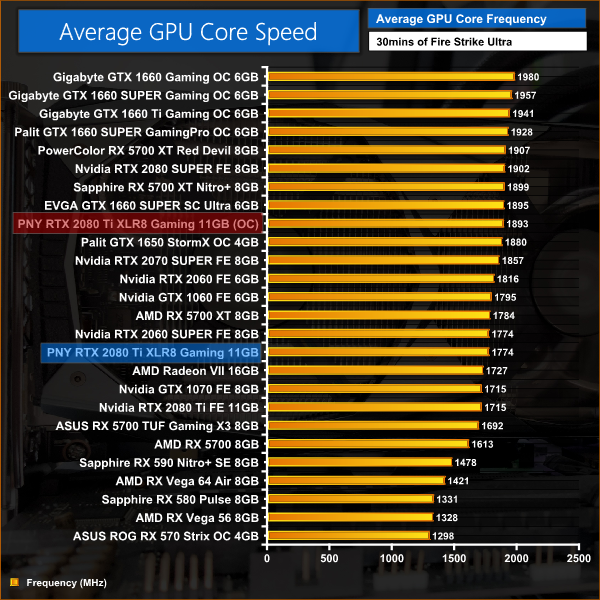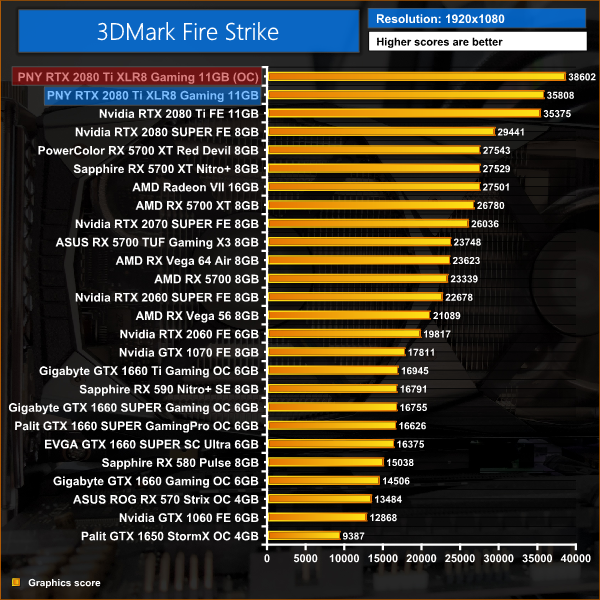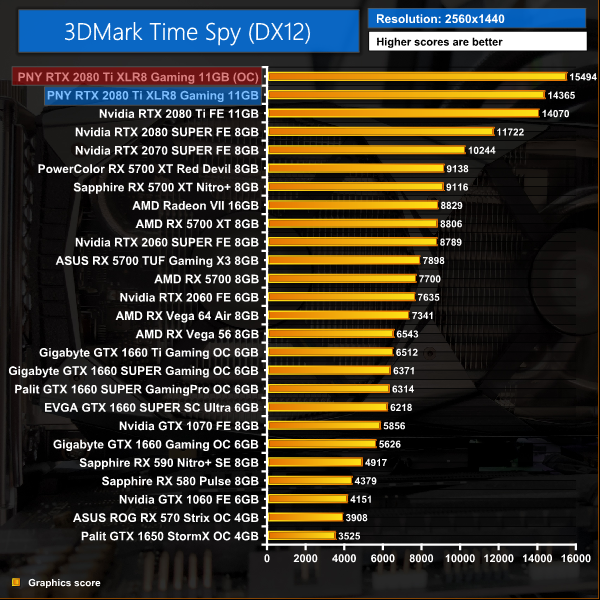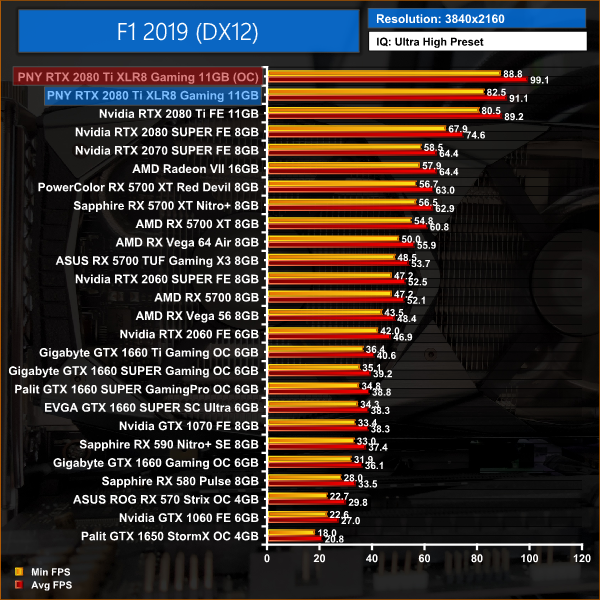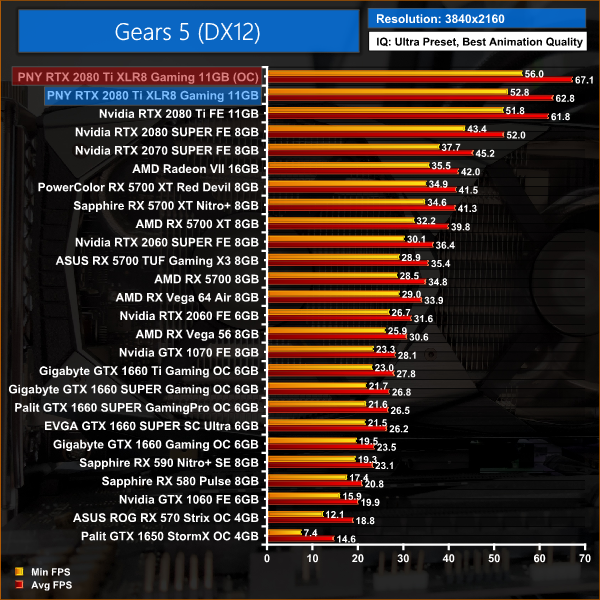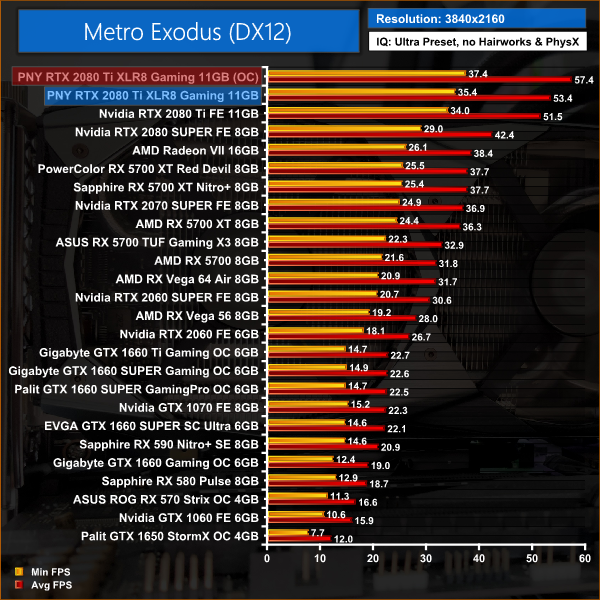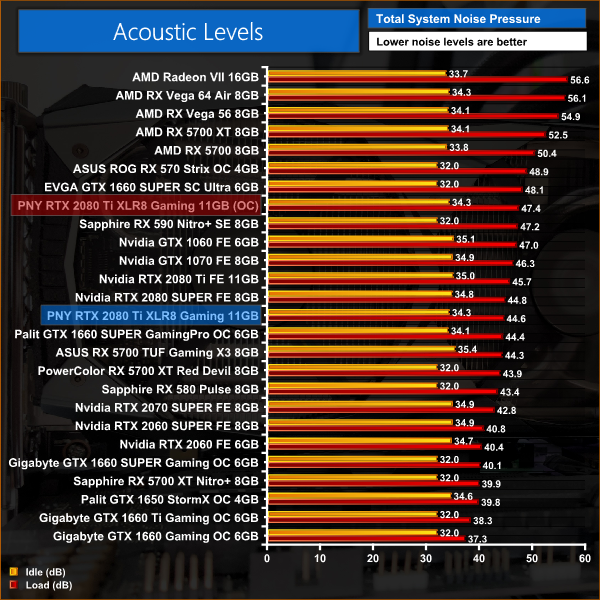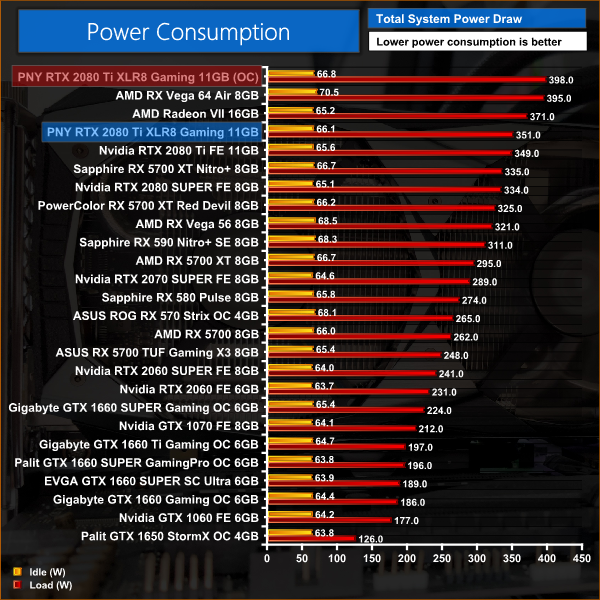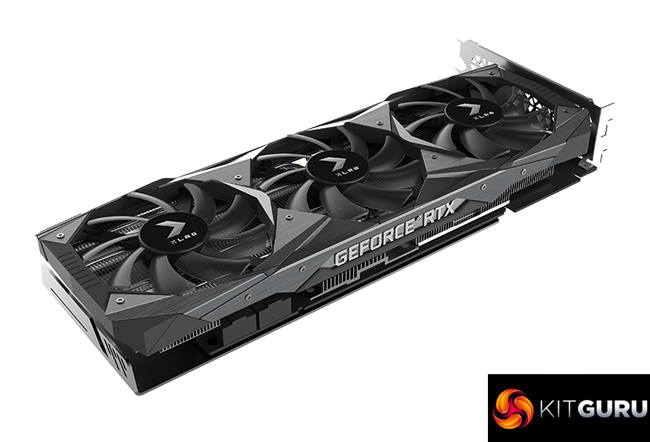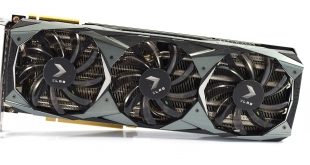
Nvidia's RTX 2080 Ti launched over a year ago, and since then it has remained the fastest consumer graphics card on the market, withstanding challenges from AMD's Radeon VII and Nvidia's own RTX 2080 SUPER. We've reviewed a number of ultra high-end 2080 Ti custom cards, many costing close to £1500. If you don't want to spend quite so much, PNY's 2080 Ti XLR8 Gaming may be worth a look – it's a triple-fan card that's priced just over £1000.
There's no such thing a ‘cheap' RTX 2080 Ti, but for a card like PNY's XLR8 Gaming the price of £1009 is somewhat lower than we have seen from other triple-fan behemoths like MSI's Lightning Z. Despite that, the XLR8 Gaming still ships with a weighty, three-fan cooler while its shroud also sports some aluminium plates as well.
We've updated a number of our games since our initial 2080 Ti review, so how well does this card perform when testing some of the latest titles? Let's find out.
| GPU | RTX 2080 Ti (FE) | RTX 2080 SUPER | RTX 2080 (FE) | RTX 2070 SUPER | RTX 2070 (FE) |
| SMs | 68 | 48 | 46 | 40 | 36 |
| CUDA Cores | 4352 | 3072 | 2944 | 2560 | 2304 |
| Tensor Cores | 544 | 384 | 368 | 320 | 288 |
| Tensor FLOPS | 114 | 89 | 85 | 72 | 63 |
| RT Cores | 68 | 48 | 46 | 40 | 36 |
| Texture Units | 272 | 192 | 184 | 160 | 144 |
| ROPs | 88 | 64 | 64 | 64 | 64 |
| Rays Cast | 10 Giga Rays | 8 Giga Rays | 8 Giga Rays | 7 Giga Rays | 6 Giga Rays |
| GPU Boost Clock | 1635 MHz | 1815 MHz | 1800 MHz | 1770 MHz | 1710 MHz |
| Memory Data Rate | 14 Gbps | 15.5 Gbps | 14 Gbps | 14 Gbps | 14 Gbps |
| Total Video Memory | 11GB GDDR6 | 8GB GDDR6 | 8GB GDDR6 | 8GB GDDR6 | 8GB GDDR6 |
| Memory Interface | 352-bit | 256-bit | 256-bit | 256-bit | 256-bit |
| Memory Bandwidth | 616 GB/sec | 496.1 GB/sec | 448 GB/sec | 448 GB/sec | 448 GB/sec |
| TGP | 260W | 250W | 225W | 215W | 185W |
Before we get into the review itself, let's just remind ourselves of the core spec of RTX 2080 Ti. Using the TU102 GPU, with a 754 mm² die size, this is nothing short of a monster – 68 Streaming Multiprocessors, each with 64 CUDA Cores, gives this GPU total of 4352 cores, which is still over 1200 more than the RTX 2080 SUPER which launched in July. Each SM also houses one RT Core, so we have 68 of those used to power real-time ray tracing in games which support the technology.
Boost clocks for this card are unchanged from the Founders Edition, with a 1635MHz rated clock speed. Technically this means the card is factory overclocked, as true reference clock for 2080 Ti is 1545MHz boost, but PNY hasn't pushed clocks further than the Founders Edition.
Elsewhere, the 11GB of GDDR6 memory is the most VRAM we've seen on a consumer RTX card, though it is clocked at 14Gbps instead of 15.5Gbps as per 2080 SUPER. Still, over a 352-bit bus this puts total memory bandwidth at 616 GB/s. Lastly, total graphics power (TGP) is rated at 260W.
The PNY RTX 2080 Ti XLR8 Gaming ships in a fairly simple box, with only the XLR8 and GeForce branding on the front – there's no image of the card itself here.
Inside, the only accessory is a small ‘quick install' guide.
The card itself is what we are here for, though, and we can immediately see the monochrome yet fairly aggressive styling PNY has gone for with this card. The main body of the shroud is matte black plastic, yet there are a number of angular metal plates screwed onto of the plastic which give it that somewhat aggressive look. The card doesn't feel as premium as the Founders Edition, but it is still fairly weighty and doesn't feel cheap in the hand.
As for the three fans, these measure 90mm in diameter. I'm not so keen on the glossy plastic used for the fan blades, however, as while this is of course subjective, I think matte black would have looked a bit cleaner as the glossy plastic just cheapens the overall look in my opinion.
It's also worth touching on the dimensions of this card – it measures 314 x 128 x 44mm. That's quite a long card then, yet it is not very tall and only a dual-slot thickness. The length is the most likely aspect to cause issues with case compatibility, so as always I suggest double-checking that this won't interfere with any front fans or brackets etc.
On the front side of the card we can get a look at the NVLink finger used for SLI, as well as the GeForce RTX logo – though do note there is no lighting on this card, so don't expect this to glow when powered on.
As for the backplate, this is a full-length design which is made of aluminium. It is plain black, apart from more GeForce branding, though it does feature plenty of cut-outs as well.
Power requirements and display outputs are standard for a 2080 Ti – with 2x 8-pin PCIe power connectors, and then 3x DisplayPort, 1x HDMI and 1x USB-C VirtualLink display connectors.
Prising off the cooler only requires the removal of six screws, and then we can get a look at the PCB. We'll look at the VRM in more detail below, as PNY has fitted a finned heatsink on top of the right-hand side MOSFETs and chokes which is a nice touch, but starting with the memory it is no surprise to see the modules coming from Micron, each one labelled ‘8QA77D9WCW.' We can also see the big TU102 GPU, labelled ‘TU102-300A-K1-A1'.
To remove the VRM heatsink, four screws need to be removed from the back of the PCB, which requires the removal of the backplate. Once that is done, we can get an unobstructed look at the PCB, and we can clearly see it is a reference board. That means it uses a 13+3 phase VRM, with 7 GPU phases and 3 memory phases hidden under that heatsink.
As for the cooler, this is comprised of two separate fin stacks which are connected by five heatpipes – 4x 8mm and 1x 6mm. The GPU itself contacts with a copper coldplate, but there is a separate plate for the VRAM modules and the VRM positioned to the left of the GPU (i.e, the MOSFETs not covered by the finned heatsink).
Our newest GPU test procedure has been built with the intention of benchmarking high-end graphics cards. We test at 1920×1080 (1080p), 2560×1440 (1440p), and 3840×2160 (4K UHD) resolutions.
We try to test using the DX12 API if titles offer support. This gives us an interpretation into the graphics card performance hierarchy in the present time and the near future, when DX12 becomes more prevalent. After all, graphics cards of this expense may stay in a gamer’s system for a number of product generations/years before being upgraded.
We tested the RX Vega64 and Vega56 using the ‘Turbo‘ power mode in AMD’s WattMan software. This prioritises all-out performance over power efficiency, noise output, and lower thermals.
Driver Notes
- All AMD graphics cards were benchmarked with the Adrenalin 19.9.2 driver.
- All Nvidia graphics cards (except 1660 SUPER) were benchmarked with the Nvidia 436.48 driver.
- All GTX 1660 SUPER graphics cards were benchmarked with the Nvidia 441.07 driver supplied to press ahead of launch.
Test System
We test using the Overclockers UK Germanium pre-built system, though it has been re-housed into an open-air test bench. You can read more about it over HERE.
| CPU |
Intel Core i7-8700K
Overclocked to 5.0GHz |
| Motherboard |
ASUS ROG Strix Z370-F Gaming
|
| Memory |
Team Group Dark Hawk RGB
16GB (2x8GB) @ 3200MHz 16-18-18-38 |
| Graphics Card |
Varies
|
| System Drive |
Samsung 960 EVO 500GB
|
| Games Drive | Kingston UV500 960GB |
| Chassis | Streacom ST-BC1 Bench |
| CPU Cooler |
OCUK TechLabs 240mm AIO
|
| Power Supply |
Corsair AX1500i 80+ Titanium PSU
|
| Operating System |
Windows 10 1903
|
Comparison Graphics Cards List
- Nvidia RTX 2080 Ti Founders Edition (FE) 11GB
- Nvidia RTX 2080 SUPER Founders Edition (FE) 8GB
- Nvidia RTX 2070 SUPER Founders Edition (FE) 8GB
- Nvidia RTX 2060 SUPER Founders Edition (FE) 8GB
- Nvidia RTX 2060 Founders Edition (FE) 6GB
- Gigabyte GTX 1660 Ti OC 6G
- EVGA GTX 1660 SUPER SC Ultra 6GB
- Gigabyte GTX 1660 SUPER Gaming OC 6G
- Palit GTX 1660 SUPER GamingPro OC 6GB
- Gigabyte GTX 1660 Gaming OC 6G
- Palit GTX 1650 StormX OC 4GB
- Nvidia GTX 1060 Founders Edition (FE) 6GB
- AMD RX 5700 XT 8GB
- PowerColor RX 5700 XT Red Devil 8GB
- Sapphire RX 5700 XT Nitro+ 8GB
- ASUS RX 5700 TUF Gaming X3 8GB
- AMD RX 5700 8GB
- AMD Radeon VII 16GB
- AMD RX Vega 64 Air 8GB
- AMD RX Vega 56 8GB
- Sapphire RX 590 Nitro+ SE 8GB
- Sapphire RX 580 Pulse 8GB
- ASUS RX 570 ROG Strix Gaming OC 4GB
Software and Games List
- 3DMark Fire Strike & Fire Strike Ultra (DX11 Synthetic)
- 3DMark Time Spy (DX12 Synthetic)
- 3DMark Port Royal (DXR Synthetic)
- Battlefield V (DX12)
- The Division 2 (DX11)
- F1 2019 (DX12)
- Far Cry New Dawn (DX11)
- Gears 5 (DX12)
- Ghost Recon: Wildlands (DX11)
- Metro: Exodus (DX12)
- Middle Earth: Shadow of War (DX11)
- Shadow of the Tomb Raider (DX12)
- Total War: Three Kingdoms (DX11)
We run each benchmark/game three times, and present averages in our graphs.
3DMark Fire Strike is a showcase DirectX 11 benchmark designed for today’s high-performance gaming PCs. It is our [FutureMark’s] most ambitious and technical benchmark ever, featuring real-time graphics rendered with detail and complexity far beyond what is found in other benchmarks and games today.
As expected, the PNY 2080 Ti XLR8 Gaming claims top spot in all three of our 3DMark benchmarks, outperforming the 2080 Ti Founders Edition (FE) by 2%.
3DMark Port Royal is the world’s first dedicated real-time ray tracing benchmark for gamers. You can use Port Royal to test and compare the real-time ray tracing performance of any graphics card that supports Microsoft DirectX Raytracing. As well as benchmarking performance, 3DMark Port Royal provides a realistic and practical example of what to expect from ray tracing in upcoming games.
Port Royal is designed specifically to test a card's ray tracing abilities, with the XLR8 out-pointing the Founders Edition by over 130 points. Compared to 2080 SUPER, the gap is almost 2000 points.
Battlefield V is a first-person shooter video game developed by EA DICE and published by Electronic Arts. Battlefield V is the sixteenth instalment in the Battlefield series. It was released worldwide for Microsoft Windows, PlayStation 4, and Xbox One on November 20, 2018. (Wikipedia).
We test using the Ultra preset, DX12 API.
Battlefield V is a well optimised title and allows the 2080 Ti to really stretch its legs, delivering almost 160FPS with Ultra settings at 1080p. 4K gamers will also see a solid 80FPS average from the PNY XLR8.
Tom Clancy's The Division 2 is an online action role-playing video game developed by Massive Entertainment and published by Ubisoft. The sequel to Tom Clancy's The Division (2016), it is set in a near-future Washington, D.C. in the aftermath of a smallpox pandemic, and follows an agent of the Strategic Homeland Division as they try to rebuild the city. (Wikipedia).
We test using the Ultra preset, but with V-Sync disabled, DX11 API.
While the 2080 Ti can't quite push 60FPS at 4K/Ultra with The Division 2, it's still a remarkably smooth experience at that resolution. Averaging over 100FPS at 1440p, too, shows that this is a great high-refresh rate 1440p card.
F1 2019 is a racing video game based on the 2019 Formula One and Formula 2 Championships. The game is developed and published by Codemasters and is the twelfth title in the Formula One series developed by the studio. The game was announced by Codemasters on 28 March 2019. (Wikipedia).
We test using the Ultra High preset, with TAA and 16x Anisotropic Filtering, DX12 API.
F1 2019 is a less demanding title than some others we test, and accordingly the XLR8 reaches almost 200FPS average at 1080p, even using Ultra High settings. 4K gamers would even get good mileage out of a pricy 4K/144Hz monitor, with this card averaging 91FPS at 2160p.
Far Cry New Dawn is an action-adventure first-person shooter developed by Ubisoft Montreal and published by Ubisoft. The game is a spin-off of the Far Cry series and a narrative sequel to Far Cry 5. It was released for Microsoft Windows, PlayStation 4 and Xbox One on February 15, 2019. (Wikipedia).
We test using the Ultra preset, with the HD Textures pack, DX11 API.
Despite a noticeable CPU bottleneck when gaming at 1080p, the 2080 Ti XLR8 still sits top of the pile in Far Cry New Dawn. At 4K, we're again pushing over 80FPS average.
Gears 5 is a third-person shooter video game developed by The Coalition and published by Xbox Game Studios for Microsoft Windows and Xbox One. It is the sixth instalment of the Gears of War series, and is the second Gears of War game not to be developed by Epic Games.
We test using the Ultra preset, with Best Animation Quality (instead of Auto), DX12 API.
Gears 5 is a recent release and is a great benchmarking tool, with plenty of settings available to tweak. At 1440p this card is capable of delivering over 100FPS on average, while 4K/60 gameplay is also achieved with Ultra settings.
Tom Clancy’s Ghost Recon Wildlands is a tactical shooter video game developed by Ubisoft Paris and published by Ubisoft. It was released worldwide on March 7, 2017, for Microsoft Windows, PlayStation 4 and Xbox One, as the tenth instalment in the Tom Clancy’s Ghost Recon franchise and is the first game in the Ghost Recon series to feature an open world environment. (Wikipedia).
We test using the Very High preset, DX11 API.
Despite being an older title, Wildlands is still a stern test for modern GPUs and we see that with results very similar to Gears 5 – over 100FPS on average at 1440p, with 4K gameplay offering 68FPS average, with minimums of 53FPS.
Metro Exodus is a first-person shooter video game developed by 4A Games and published by Deep Silver in 2019. It is the third instalment in the Metro video game series based on Dmitry Glukhovsky's novels, following the events of Metro 2033 and Metro: Last Light. (Wikipedia).
We test using the Ultra preset, but with Hairworks and Advanced PhysX turned off, DX12 API.
Metro Exodus is a punishing title to run with Ultra settings, particularly when using the game's built-in benchmark. Here, though, the XLR8 comes out on top at every resolution tested, offering 4% increased performance at 4K versus the Founders Edition.
Middle-earth: Shadow of War is an action role-playing video game developed by Monolith Productions and published by Warner Bros. Interactive Entertainment. It is the sequel to 2014’s Middle-earth: Shadow of Mordor, and was released worldwide for Microsoft Windows, PlayStation 4, and Xbox One on October 10, 2017. (Wikipedia).
We test using the Very High preset, DX11 API.
Shadow of War is starting to show its age, with the XLR8 2080 Ti able to push almost 140FPS when playing at 1440p. At 4K, average frame rate is just below 80FPS.
Shadow of the Tomb Raider is an action-adventure video game developed by Eidos Montréal in conjunction with Crystal Dynamics and published by Square Enix. It continues the narrative from the 2013 game Tomb Raider and its sequel Rise of the Tomb Raider, and is the twelfth mainline entry in the Tomb Raider series. The game released worldwide on 14 September 2018 for Microsoft Windows, PlayStation 4 and Xbox One. (Wikipedia).
We test using the Highest preset, with AA disabled, DX12 API.
Like many of our games today, the XLR8 makes fairly easy work of Shadow of the Tomb Raider, offering over 60FPS at all times when gaming at 4K. 1440p gamers can expect to stay above 100FPS, too.
Total War: Three Kingdoms is a turn-based strategy real-time tactics video game developed by Creative Assembly and published by Sega. As the 12th mainline entry (the 13th entry) in the Total War series, the game was released for Microsoft Windows on May 23, 2019.
We test using the Ultra preset, DX11 API.
Total War: Three Kingdoms is a resource-heavy title which can sap a GPU, especially at 4K. There we saw the XLR8 2080 Ti average 45FPS, with 1440p gaming offering almost 90FPS on average.
Battlefield V is a first-person shooter video game developed by EA DICE and published by Electronic Arts. Battlefield V is the sixteenth instalment in the Battlefield series. It was released worldwide for Microsoft Windows, PlayStation 4, and Xbox One on November 20, 2018. (Wikipedia).
We test using the Ultra preset, DX12 API. Battlefield V was the first game released with Nvidia RTX ray tracing features (called DXR in game) and we present average frame rates for the game with DXR Off, and then again with DXR set to Ultra.
As our final gaming test of the day, we look at the card's ray tracing ability. At 1080p in Battlefield V, the 2080 Ti is able to average almost 90FPS with DXR set to Ultra, giving a very smooth experience despite the 45% performance drop versus DXR off. 1440p is also playable with a 70FPS average, though 4K with DXR Ultra is somewhat choppier.
Here we present the average clock speed for each graphics card while running the 3DMark Fire Strike Ultra stress test for 30 minutes. We use GPU-Z to record the GPU core frequency during the Fire Strike Ultra runs. We calculate the average core frequency during the 30 minute run to present here.
Looking at the card's clock speed under load, after a 30min Fire Strike Ultra stress test we saw the clock speed average 1774MHz, almost 60MHz faster than the Founders Edition. Both cards do have the same rated boost clock (1645MHz) but as we will see on the next page, the PNY XLR8 runs quite a bit cooler allowing GPU Boost to push clock speed further.
For our temperature testing, we measure the peak GPU core temperature under load, as well as the GPU temperature with the card idling on the desktop. A reading under load comes from running the 3DMark Fire Strike Ultra stress test for 30 minutes. An idle reading comes after leaving the system on the Windows desktop for 30 minutes.
With a peak operating temperature of 67C on the GPU core, PNY's cooling solution is certainly effective. This marks an 8C reduction in temperature versus the Founders Edition, which allows the core to run about 60MHz faster under load.
There's nothing to worry about in regards to the thermal camera images, with hotspots around 59C on both the front and back of the card.
We take our noise measurements with the sound meter positioned 1 foot from the graphics card. I measured the noise floor to be 32 dBA, thus anything above this level can be attributed to the graphics cards. The power supply is passive for the entire power output range we tested all graphics cards in, while all CPU and system fans were disabled.
A reading under load comes from running the 3DMark Fire Strike Ultra stress test for 30 minutes. An idle reading comes after leaving the system on the Windows desktop for 30 minutes.
Noise output is the one area where PNY could have done a bit better. The XLR8 isn't a loud card – it's still about 1dB quieter than the Founders Edition – but it is still audible and we have tested significantly quieter aftermarket cards in the past.
For reference, under load we observed the three fans spinning at around 1890rpm, or 58%. I think there is definitely scope to slow the fans a bit given the impressive thermal performance of the card, resulting in lower noise levels.
We measure system-wide power draw from the wall while the card is sat idling at the Windows 10 desktop for 30 minutes. A reading under load comes from running the 3DMark Fire Strike Ultra stress test for 30 minutes.
Given the XLR8 uses a reference PCB, it's no surprise to see power draw is very similar to the Founders Edition, with just a couple of watts between the two.
To overclock the card, I used MSI Afterburner. My best result came with +80MHz to the GPU core and +900MHz to the memory.
Average clock speed under load
This overclock saw the XLR8's average clock speed increase by just over 100MHz.
Games
This resulted in performance increasing by between 7-9%, with the biggest gain coming in F1 2019 when tested at 4K.
Here, we take a further look at the impact of our overclock, looking at the increased temperatures, acoustics and power draw.
Temperatures
Acoustics
Power consumption
Overview
The card still ran reasonably well when dealing with this overclock, with core temperatures increasing just just 2C. Noise levels rose another 3dB, making the card reasonably loud under load, while power draw rose by almost 50w compared to stock behaviour.
It has been a fair while since we reviewed a RTX 2080 Ti, and while its pricing means this is only for the cash-rich enthusiasts out there, it is still a lot of fun to see exactly what £1000 can get you in the graphics department.
Starting with the overall look at feel of this PNY RTX 2080 Ti XLR8 Gaming model that we have reviewed, it's a fairly simple design that doesn't stand out too much. It does have a fairly aggressive appearance when looking at the front of the shroud, thanks to the angular metal plates screwed into the plastic shroud, but assuming you will install this case horizontally, you will be looking onto the plain black backplate which is much less distinct.
Despite the fairly hefty heatsink and triple 90mm fan cooler, PNY left the card running at the same 1635MHz boost clock speed as the 2080 Ti Founders Edition. Technically this means the card is factory overclocked, as reference spec for the card has a boost clock of 1545MHz, but it would have been nice for PNY to push things out a bit further.
Still, the card's beefy cooler means GPU Boost can take clock speed about 60MHz higher than the Founders Edition, and that gave PNY a 2% lead on average throughout all of the games we tested. Relative to RTX 2080 SUPER, the XLR8 is on average 19% faster, while its a 40% difference between this card and AMD's Radeon VII. It was the same when 2080 Ti launched, and it holds true today – the Turing flagship really is in a class of its own.
This means the card really is the go-to for 4K/60 gaming. In fact, of the ten games we tested today, only three averaged less than 60FPS when using Very High or Ultra settings, and two of those three still averaged 53FPS or more. 1440p gamers will also find this card perfect for a 144Hz monitor, with 8 of the 10 titles tested delivering over 100FPS on average at that resolution.
As for the XLR8's technical performance, it's a decent card. It peaked at just 67C on the GPU core, marking an 8C reduction in temperature over the Founders Edition. There's no practical difference in power draw between the two cards either, with noise levels being the one area I would've liked to see a bit more from this card – it's still quieter than the Founders Edition, but it's by no means silent. Lowering fan speeds, for slightly higher GPU temperatures, would be a fair trade-off in my view.
Overall, the PNY RTX 2080 Ti XLR8 Gaming is a solid offering. Compared to some of its pricier brethren, it is fair to say it is lacking a few features – there's no RGB lighting, no fan-stop mode and no fun accessories in the box. It's also not the quietest card I have ever tested. Still, at £1009 this is one of the cheaper RTX 2080 Ti partner cards going – it's not a cheap card by any stretch of the imagination, but if you don't want to spend £1500 on a different model, this will give you that class-leading performance in a simpler package.
You can buy the card for £1009.99 on Amazon UK HERE.
Discuss on our Facebook page HERE.
Pros
- Fastest consumer card going.
- Monochrome styling.
- Runs cool.
- Cheaper than many other custom cards.
Cons
- Could be quieter.
- Missing some features.
KitGuru says: There's no such thing as an ‘affordable' RTX 2080 Ti, but if you want the GPU's class-leading performance without the extra bells and whistles to drive up the price, the PNY XLR8 is worth buying.
Be sure to check out our sponsors store EKWB here
 KitGuru KitGuru.net – Tech News | Hardware News | Hardware Reviews | IOS | Mobile | Gaming | Graphics Cards
KitGuru KitGuru.net – Tech News | Hardware News | Hardware Reviews | IOS | Mobile | Gaming | Graphics Cards


